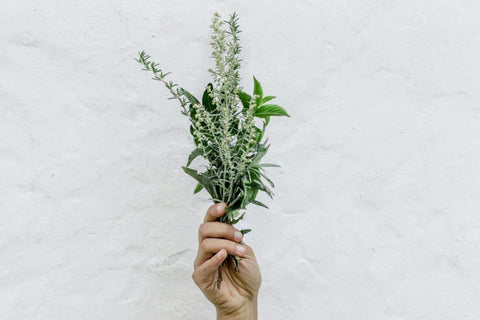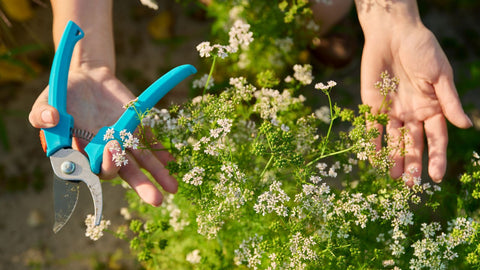The approach we take to gardening is to think about the plant’s native habitat, then replicate it in a small container. Fortunately, all herbs are covered by just two groupings: ones that like rocky, dry soil and ones that like rich, moist soil. We’ll provide separate instructions for these two groupings – dig in below!
1. Herbs that Like Moist Soil
Store-bought tender herbs rarely make it to the plate – we’ll use a couple of leaves from the little plastic clamshell and return the package to wilt in our fridge before throwing it out the following week. Either this, or we won’t want to run out to pick up basil because our pasta will be fine without it. On the other hand keeping a live plant, where you can just pick what you need is easy – as long as you give them enough water and nutrients (and enough light too, of course). In this blog, we’ll review the category, your planter options, and how to take care of them for healthy, productive plants.
What are the Tender Herbs?
These are low growing plants with soft, large leaves that are native to places like riverbanks, where rich soil and consistent access to water allows them to grow quickly. They include Basil, Parsley, Mint & Lemon Balm. From a culinary perspective they’re “Soft Herbs” that you add fresh while cooking – right at the end of the recipe. They also tend to be shorter lived seasonal plants, but there are some indoor gardening tricks to keep them producing longer – some for years and years!
What’s the best planter for Tender Herbs?
Free Draining Pot vs Self Watering Planter
These plants like consistent, moist soil. If you’re good about daily check-ups, feeling the soil moisture, and adding water as needed, then a simple pot can work well. If you’re like most of us, and are better with a weekly routine or don’t know how much water to add, a self-watering planter is really helpful. Beyond fitting into our lives better, they keep more consistent soil conditions for the plants. So for practicality and productivity reasons, we recommend going with a self-watering planter over a free-draining pot for all tender herbs & leafy greens.
The roots of these plants are more resistant to root rot (unlike the Mediterranean herbs) so they can work in all types of self-watering planters. We still recommend going with a ceramic-based self-watering planter for its precision, cleanliness, and flexibility to grow whatever you want, but these plants should also work in the boggy soil of wick-based planters.
Self Watering Planter vs. Hydroponics
As these plants like wet soil, they can also all grow hydroponically – where the roots grow directly into nutrient enriched water. Hydroponics come in all shapes and sizes, but they typically have a pump to move water and need a special type of nutrients, so they tend to be more expensive. Also, these grow just as well in consistently moist soil, so we don’t find hydroponics to be worth the extra complexity. However, Basil, in particular, can grow twice as fast in hydroponics so if lots of basil is important to you, it’s worth the investment.

How To Grow Leafy Greens In A Ceramic Self Watering Planter
The instructions below are most relevant to our upcoming Self Watering Planter that we’re aiming to release summer 2021. There are a couple of current options on the market, including Wet Pots, COSWIP, and the Great Northern. Of these, the Wet Pots keeps the best soil moisture levels for tender herbs.
Water Level
The ceramic material used in different planters lets in different amounts of water, but the wetness of the soil will be directly proportional to how high you fill the reservoir. Other factors like how big your plant is and how much light it gets will impact the level that you’ll want to fill the reservoir to – so it’s best to pay attention to the soil. With tender herbs, you want to keep the soil fairly wet. Start by letting the water drop down until the top ½ inch of soil is dry – this is your “low fill” line. Fill the planter to the top whenever it goes below this mark.
What Type of Soil to Use
Regular potting mix is made for these types of plants – it works great! When starting, we recommend adding an initial charge of balanced slow release fertilizer, following the manufacturer’s recommendation that will help feed your plant for the first 3 months.
When to Add Nutrients
These are moderate feeders – they grow quickly so need additional nutrients to replace what they use. As they are mostly growing leaves they prefer a High-N fertilizer. If you start to notice pale leaves or slower growth you should add more fertilizer. You can use water soluble (every 1-2 weeks), granular (4-8 weeks), or slow-release (10-14 weeks) following the manufacturer’s dose. If you are using a liquid fertilizer, be careful to not get it on the plant leaves.
Companions
Mint and lemon balm tend to be so aggressive that they’ll end up taking over a container if anything else is planted with them. Basil and Parsley make good companions for Leafy Greens and Vegetables.
2. Herbs that Like Dry Soil
Plants and dry soil usually go together like peanut butter and french fries, but some select plants prefer quick draining, gritty, nutrient-poor soil. It’s what they’ve evolved for! In fact, many of our favorite herbs are native to the Mediterranean basin – where the soil is sandy, dry, and chalky and the summers are hot and dry. This origin tells us a lot about the ideal conditions for healthy, long-lived, flavorful plants.
What are the Mediterranean Herbs?
Herbs that are busy or sprawling with woody stems are called “Hard” while herbs that are entirely tender are called “soft”. They are used slightly differently in cooking, and hard herbs can endure slightly harsher conditions, but they can all be grown in the same situation and thrive.
Hard Herbs
Rosemary, sage, thyme and oregano make up the hard herb category. With their gray-green foliage and shrubby stature, these “hard herbs” are easy to imagine on a sunny Mediterranian hilltop and can thrive in poor soil. They grow a bit slower and concentrate essential oils in their leaves, so are added at the beginning of cooking to release all of their bound up flavors.
Soft Herbs
Based on their looks alone these herbs (Dill, Cilantro, and Chives) aren’t an obvious fit for dry soil, though they grow and taste better with limited water. They grow faster than the Hard herbs, are shorter-lived plants and, in the kitchen, are added fresh at the end of the recipe.

What’s the best planter for these herbs?
Based on their open, free-draining native habitat, Mediterranean herbs seem like a good fit for a pot filled with the right dirt, but the performance of a smartly designed self-watering planter is tough to compete with.
Free Draining Pot vs. Self Watering Planter
The main concern with Mediterranean herbs is that their roots sit in soggy soil – they aren’t well-adapted for soaking in water and are prone to rotting. On the other hand, these plants are not fully drought tolerant and need consistent access to water. In nature, they develop big root systems to access limited water as the soil would dry out between rain. Mimicking this with a pot and soil takes a very large container! The right self-watering planter can provide more consistent conditions – and do it in a lot less space with a lot less to maintain.
Self Watering Planters: Wicking vs. Ceramic
Some self-watering planters are able to maintain perfectly consistent, slightly moist soil, while most have hardly any control. Systems that rely on a wick (the vast majority) tend to have soggy soil and roots that grow directly into the reservoir. A growing number of self-watering planters are instead using a semi-permeable ceramic membrane to control the soil moisture. It’s a mouthful, but basically, the planter will only let more water in once the soil dries out past a certain level. This gives us a fine degree of control and there’s no way for the roots to get into the reservoir. If you want to geek out even more on SWP’s check out our R&D tests [coming soon].
Hydroponics vs. Soil
While these plants can be grown hydroponically – their predisposition to health issues and poor growth in soggy conditions makes soil based systems a much better fit.

How To Grow Mediterranian Herbs In A Ceramic Self Watering Planter
The instructions below are most relevant to our upcoming Self Watering Planter (to be released summer 2021) but will work for most ceramic self-watering planters. There are a couple of current options on the market, including Wet Pots, COSWIP, and the Great Northern. Of these, the Great Northern keeps the best soil moisture levels for Mediterranean herbs.
Water Level
The ceramic material used in the different planters lets in different amounts of water, but the wetness of the soil will be directly proportional to how high you fill the reservoir. Other factors like how big your plant is and how much light it gets will impact the water level that you’ll want to fill the reservoir to – so it’s best to pay attention to the soil. If the soil surface is ever wet, you’ll know it’s filled too high. Let the water drop down until the soil surface dries – this is your “high fill” line for mediterranean herbs. Let the water level drop to the bottom of the reservoir between refills.
Best Potting Soil Mix
While plants are amazingly adaptable, looking at where they originate from points us to the best soil for long term health. All the Mediterranean herbs love chalkly, porous, alkaline soil, and may not taste very flavorful if grown in soil that’s too rich. For off-the-shelf options, cactus mixes tend to work well. For an easy DIY mediterranean soil, start with a regular potting mix and add in ⅓ vermiculite or perlite.
Additional Nutrients
As they are accustomed to “poor” soils, none of the Mediterranean herbs need very much additional nutrients and range between being light feeders and very light feeders. Depending on how rich your starting soil was, it can be upto a year before you should add nutrients. Once its time, (you may notice pale leaves) add slow release fertilizer, following the manufacturer’s “light feed” dose recommendations.
Companions
Mediterranean herbs like their personal space. They are used to open areas with ample air circulation and space for their roots to spread.











There are no comments for this article. Be the first one to leave a message!